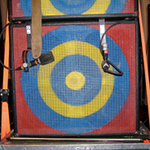Ross Racine
North of Piney Acres
Front Room
147 Roebling Street, Brooklyn, NY
April 29–May 29, 2011
Critiques of the suburbs rarely stray from charges that they are, at best, safe and predictable and, at worst, isolated and conformist. From the ticky-tacky houses spoofed in Weeds to the psychological unrest in Donnie Darko and American Beauty, mocking and pessimistic approaches to carefully ordered communities too often amount to retreads of old clichés, however true they may be. The twelve works in Ross Racine’s latest exhibition, North of Piney Acres, depicting vast bird’s-eye views of invented lots-and-blocks subdivisions, offer a refreshingly playful yet irrefutably critical perspective. Drawn freehand in Illustrator, layered in Photoshop, and exported as ink-jet prints, his pieces use imagery that borrows from 1930s aerial photography and satellite-based Google Earth to comment on the suburban population explosion of the mid- and late twentieth century. The rings of streets and houses in Heavenly Heights (2008) ripple infinitely outward, a visual manifestation of the American housing booms that took place in the years following both World War II and 9/11. Racine’s persistent use of overcast monochrome evokes the midcentury white flight that emptied urban centers only to create other messes—in the environment, for example. Elsewhere, West of Grassy Knolls (2010) departs from the allover compositions with its secluded, insular community plotted on a gray expanse as desolate as the moon.
While Dan Graham’s Homes for America (1966) addressed mass production and consumption through deadpan parody, Racine amplifies the city planner’s logic with madcap humor. In Elmwood and Oaklawn (2009), he places industrial buildings and garbage dumps next to homes and ball fields, and the beach is nowhere to be found in Goldenwood Shores (2009). In other works, swimming pools jump from front yard to back—if proper orientation can even be identified—and carless roads loop irrationally, lead nowhere, or never intersect. Dizzying but never oppressive, Racine’s fictive neighborhoods come to suggest that urban designers today, devoted to sustainability and smart growth, have learned lessons from the past. Even residents are repurposing abandoned strip malls and big-box stores. There’s life once again in the suburbs.
Originally published at Artforum.com on May 16, 2011.






